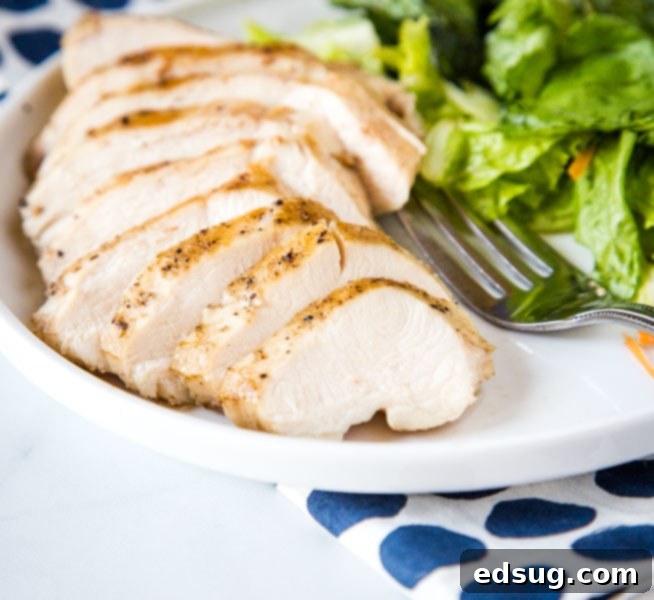Perfect Sous Vide Chicken Breast: Achieve Unbeatable Tenderness & Flavor Every Time
Unlock the secret to the most tender, moist, flavorful, and consistently delicious chicken breast you’ve ever tasted – all thanks to the magic of sous vide cooking!
My culinary journey took an exciting turn about four years ago when my husband introduced me to the world of sous vide. He was already familiar with the technique, and one Mother’s Day, he surprised me with a sous vide immersion circulator. Initially, I was skeptical, unsure what this fancy gadget could add to my cooking routine. Little did I know, it was about to revolutionize the way I prepare meals, especially proteins. The transformative power of sous vide lies in its precision; it ensures that every piece of meat, from a thick steak to a delicate chicken breast, is cooked to its absolute perfect temperature, every single time. Imagine never again biting into an overcooked steak or struggling to achieve that ideal medium-rare – with sous vide, it’s a guaranteed outcome.
This remarkable method eliminates the common pitfalls of traditional cooking, where guesswork often leads to inconsistent results. Say goodbye to dry, chewy chicken breasts or rubbery pork chops! You know those beloved Oven Baked Pork Chops everyone raves about? You can achieve even better results with sous vide! Use the exact same seasonings, cook them in a water bath, and experience pork chops that are incredibly tender, juicy, and never, ever dried out. The consistency and quality you can achieve are truly unparalleled, making this technique a game-changer for any home cook looking to elevate their dishes.
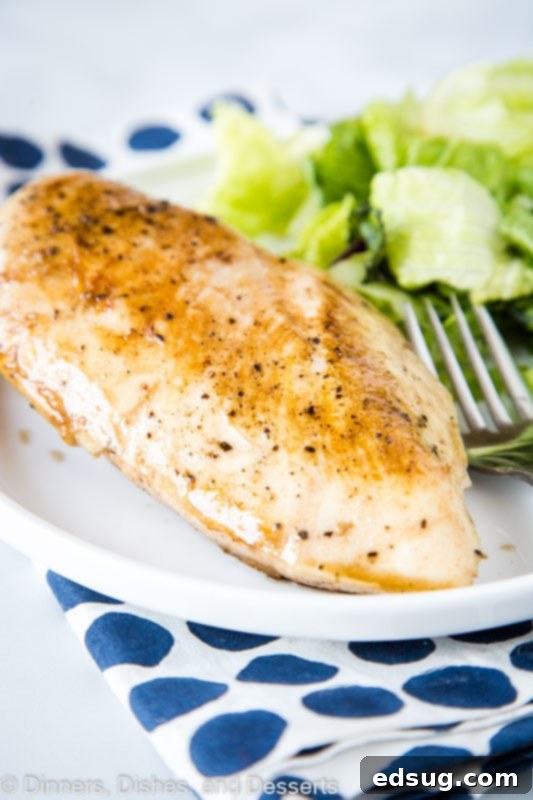
What is Sous Vide? Understanding the Precision Cooking Method
Sous vide, which translates to “under vacuum” in French, is a cooking technique where food is sealed in an airtight bag – typically vacuum-sealed – and then cooked in a precisely controlled water bath. The key component is the sous vide device, often an immersion circulator, which maintains the water at a constant, exact temperature and circulates it to ensure uniform heat distribution. This means that your food cooks evenly from edge to edge, eliminating the common problem of thinner sections drying out while thicker parts remain undercooked. With traditional methods like baking or pan-frying, external heat can often lead to a gradient of doneness, where the outside is overcooked by the time the center reaches the desired temperature.
The beauty of sous vide lies in its unparalleled precision. There’s no guesswork involved: if you set your sous vide circulator to 140 degrees Fahrenheit, your food will cook to exactly 140 degrees, no higher and no lower. The constantly circulating water acts as a thermal buffer, ensuring there are no hot spots or cool spots within the cooking vessel. This scientific approach to cooking results in food that is perfectly cooked throughout, achieving textures and levels of doneness that are simply impossible to replicate with other methods. For years, professional chefs in high-end restaurants have relied on sous vide to perfectly cook meats and other ingredients, allowing them to prepare food ahead of time and simply sear it to order, guaranteeing consistency and quality for every diner.

Is Chicken Good Sous Vide? Absolutely!
Yes, absolutely! Cooking chicken using the sous vide method is, in my opinion, the absolute best way to prepare it. If you’ve ever baked chicken or cooked it on the stovetop, you know the struggle: the thinner edges often end up dry and tough, while the thicker center might still be barely cooked or even slightly pink. Even pounding chicken thin doesn’t always guarantee even cooking or the ideal temperature throughout the entire piece. This uneven cooking is a frustrating reality with traditional methods.
However, sous vide cooking changes everything. This method delivers the juiciest, most tender, and incredibly moist piece of chicken you will ever experience. The texture is so consistently perfect that you might even question if you’re eating chicken at all! Beyond the incredible texture, sous vide offers unparalleled versatility in flavoring your chicken. You can infuse your chicken with an endless array of flavors simply by adding your chosen herbs, spices, lemon slices, garlic cloves, or even a marinade directly into the vacuum-sealed bag before cooking. As the chicken cooks slowly and evenly in the water bath, these flavors permeate every fiber of the meat, resulting in a deeply flavorful dish that is effortless to achieve. It truly makes achieving gourmet-quality chicken a simple and foolproof process.
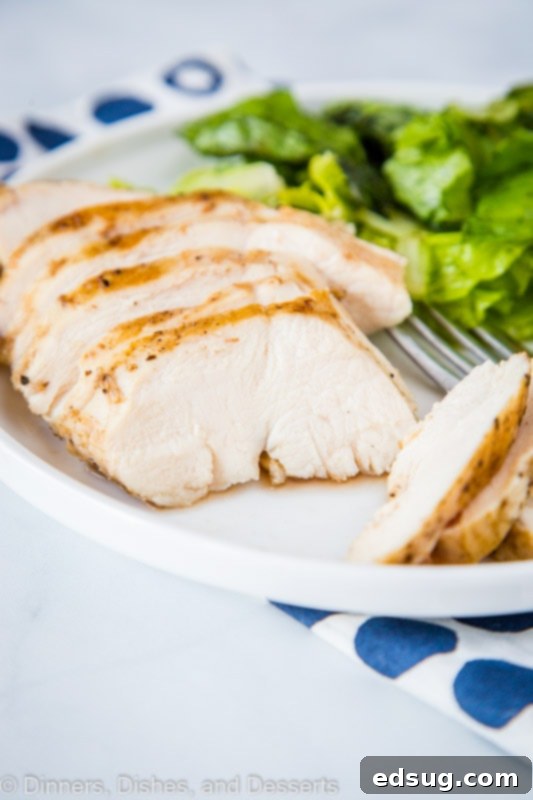
How Long Does It Take To Sous Vide Chicken Breast?
For boneless, skinless chicken breasts, the cooking time is remarkably consistent and convenient. It typically takes just one hour to cook chicken breasts to perfection using the sous vide method. The real advantage, however, is the flexibility it offers. Unlike traditional cooking where timing is critical and even a few minutes can lead to overcooking, you can leave your chicken in the water bath for an extended period without compromising quality. The texture will remain optimal for up to 4 hours before it starts to soften beyond the ideal point. This makes sous vide perfect for meal prepping or busy weeknights; you can simply “set it and forget it” for a couple of hours if your schedule requires it, without worrying about your chicken drying out or becoming overdone.
Sous Vide Chicken Breast Temperature: The Ideal Setting
I consistently set my sous vide device to 147 degrees Fahrenheit (64 degrees Celsius) for cooking chicken. This temperature might seem lower than what you’d typically aim for with conventional cooking methods, but it’s perfectly safe and yields superior results when cooked sous vide. The science behind this involves pasteurization: because the chicken is held at this precise temperature for an adequate duration (at least one hour), any harmful bacteria are effectively killed, making it completely safe to eat. You’ll observe that the chicken is thoroughly cooked all the way through, with no pink spots remaining. What you get is an incredibly tender, juicy, and succulent piece of meat that redefines what a chicken breast can be.
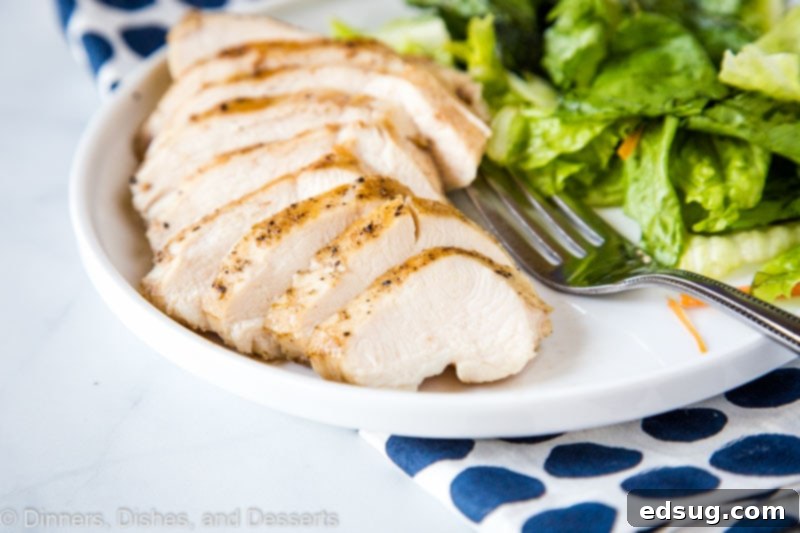
Can You Overcook Chicken in Sous Vide?
While sous vide cooking is incredibly forgiving, it is possible to “overcook” chicken if left in the water bath for too long. However, this type of overcooking is very different from the dry, tough, and stringy texture you’d get from overcooking chicken in an oven or on a grill. With sous vide, if you leave the chicken past the recommended 4-hour mark, the muscle fibers will eventually break down excessively, leading to a mushy or paste-like texture. It won’t be dried out, but it won’t have the pleasant, firm-yet-tender bite that is the hallmark of perfectly sous vide chicken. So, while it offers a generous window, it’s still best to adhere to the suggested cooking times to achieve optimal results.
What if I don’t have a Vacuum Sealer? No Problem!
No vacuum sealer? No worries! You can still enjoy the benefits of sous vide cooking. A standard zip-top food storage bag works perfectly well. The key is to remove as much air as possible from the bag to ensure good contact between the food and the circulating water. The easiest way to do this is using the water displacement method: place your seasoned chicken into the zip-top bag, slowly submerge the bag into the water bath (leaving the very top edge of the bag unzipped), and let the water pressure push the air out. Once most of the air is expelled, seal the bag. Another excellent option is to invest in reusable silicone bags; these are eco-friendly and designed to help you easily push out excess air. If, despite your best efforts, some air remains in the bag, simply place a heavy object like a ceramic plate or a weighted clip on top of the bag to keep the meat fully submerged throughout the cooking process. Ensuring the food stays completely underwater is crucial for even heat transfer.

Once your chicken has completed its sous vide bath, the next crucial step is searing it. This applies not only to chicken but also to sous vide steaks and pork chops. Searing creates that irresistible, golden-brown crust on the outside, which adds texture and a depth of flavor through the Maillard reaction. For searing after sous vide, the best oils to use are those with a very high smoke point, such as vegetable oil, canola oil, or avocado oil. These oils can withstand high temperatures without burning, which is essential for a quick and effective sear. Olive oil, with its lower smoke point, isn’t the ideal choice as it can easily smoke and impart a bitter flavor at the temperatures needed for a proper sear.
Essential Tips for Searing Sous Vide Chicken
- Thoroughly Pat Dry: This is arguably the most critical step for achieving a fantastic sear. After removing the chicken from the water bath and its bag, you’ll notice it’s quite damp from the cooking juices. Use paper towels to vigorously pat both sides of the chicken completely dry. Any residual moisture will create steam when it hits the hot pan, preventing the Maillard reaction (the browning that gives flavor and crust) and resulting in a steamed rather than seared surface.
- Get Your Pan Super Hot: Before adding the chicken, ensure your skillet (cast iron or stainless steel works best) is screaming hot, and the oil has just started to shimmer or lightly smoke. Adding the meat to a cold or lukewarm pan will prolong the searing process, which can lead to overcooking the perfectly cooked interior of the chicken. A super-hot pan ensures a quick crust without affecting the tender core.
- Sear Quickly: Aim to sear for approximately 1 to 2 minutes on each side. The goal is to develop a beautiful, golden-brown crust, not to cook the meat further. Since the chicken is already perfectly cooked through, this short, high-heat burst is solely for creating that desirable exterior texture and flavor.
- No Resting Required: One of the fantastic benefits of sous vide is that the cooking process locks all the natural juices within the meat’s fibers. Unlike grilling or roasting, where meat needs to rest to redistribute juices, sous vide chicken is ready to serve immediately after searing. This means you can get your delicious meal on the table without delay!
Sous vide chicken will undoubtedly change your perception of how chicken should be cooked. Its consistency, tenderness, and ability to perfectly infuse flavors will make it your preferred method. You have the freedom to season it however you desire before cooking – whether with a simple salt and pepper, a complex rub, or a vibrant marinade – and it will emerge as the best chicken you’ve ever tried. While the chicken cooks in its water bath, you can effortlessly prepare a complementary sauce to drizzle over it, or cook your favorite side dishes. Alternatively, the perfectly cooked and juicy chicken can be easily shredded for versatile uses in tacos, sandwiches, salads, or pasta dishes later on.
If you haven’t yet experienced the convenience and quality of sous vide, now is truly the time to consider getting a machine. It’s a life-changing investment for cooking almost any protein with consistent, restaurant-quality results. Beyond chicken, you can even make incredible Sous Vide Egg Bites, just like the popular ones from Starbucks, but even better when made fresh at home!
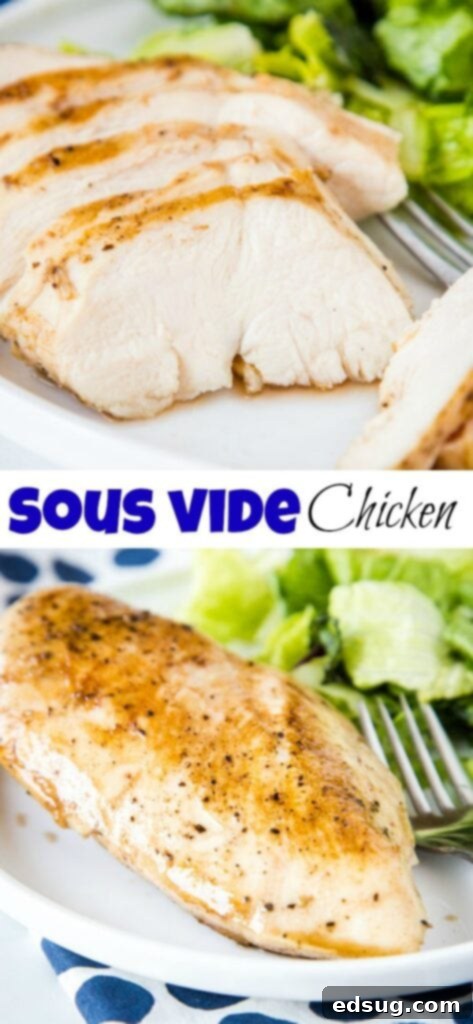
For those interested in purchasing a reliable sous vide machine, I personally use and highly recommend the Joule by Breville Sous Vide. It has proven to be an excellent, accurate, and consistently reliable device. Over the past few years, I’ve tried a couple of other models that unfortunately didn’t last, which further reinforces my confidence in the Joule’s durability and performance.
Delicious Side Dish Ideas to Complement Your Chicken
To complete your perfect meal, here are some fantastic side dish ideas that pair beautifully with sous vide chicken:
- Parmesan Garlic Roasted Edamame
- Easy Biscuits
- Instant Pot Mashed Potatoes
- Scalloped Potatoes
- Zucchini Fritters
- Loaded Twice Baked Potato Casserole
- Loaded Baked Potato
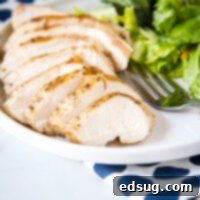
Sous Vide Chicken Breast
Pin Recipe
Rate Recipe
Print Recipe
Ingredients
- 4 chicken breasts
- salt
- pepper
- 1 Tablespoon vegetable oil
Instructions
-
Season chicken on both sides with salt and pepper.
-
Vacuum seal chicken in a plastic bag. If you don’t have a vacuum sealer, use a zip-top bag and remove as much air as possible using the water displacement method.
-
Set your Sous Vide immersion circulator to a temperature of 147 degrees Fahrenheit (64 degrees Celsius).
-
Gently lower the sealed bag of chicken into the preheated water bath and cook for 60 minutes.
-
While the chicken cooks, prepare for searing: Heat a large, heavy-bottomed skillet (like cast iron) over high heat. Add the vegetable oil and allow it to heat until it shimmers or just begins to lightly smoke.
-
Once cooked, carefully remove the chicken from the plastic bag. Using paper towels, thoroughly blot both sides of the chicken dry. This step is crucial for achieving a good sear.
-
Carefully add the dried chicken to the very hot pan. Sear for 1 to 2 minutes on each side, or until a beautiful golden-brown crust has formed. Avoid over-searing to maintain the chicken’s internal tenderness.
-
Serve immediately and enjoy the most tender and juicy chicken breast!
Notes
Nutrition
Nutrition information is automatically calculated, so should only be used as an approximation.
Additional Info
Like this recipe? Leave a comment below!
I’ve created a fun and engaging community group on Facebook, and I would absolutely love for you to join us! It’s a wonderful space where you can share YOUR favorite recipes, ask cooking-related questions, and stay updated on all the latest content from Dinners, Dishes and Desserts (so you never miss out on a new, delicious recipe!).
Be sure to follow me on Instagram and
tag #dinnersdishes so I can see all the wonderful DINNERS, DISHES, AND DESSERTS
recipes YOU make and share!
Stay connected and be sure to follow me on my social media channels, so you
never miss an update or a new post!
Facebook | Twitter | Pinterest | Instagram
.
